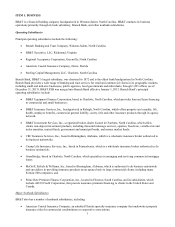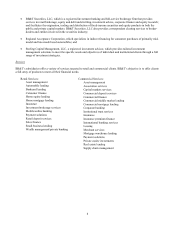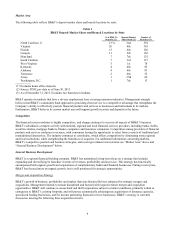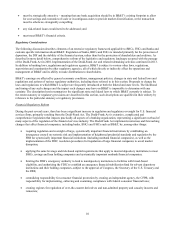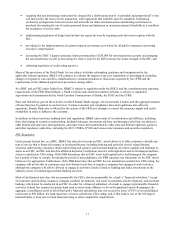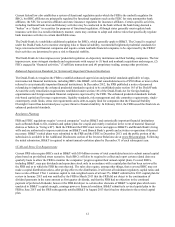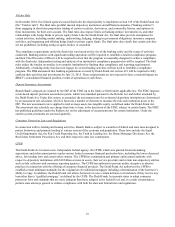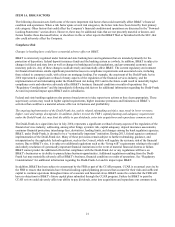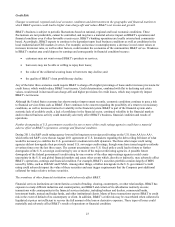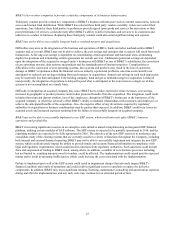BB&T 2013 Annual Report Download - page 17
Download and view the complete annual report
Please find page 17 of the 2013 BB&T annual report below. You can navigate through the pages in the report by either clicking on the pages listed below, or by using the keyword search tool below to find specific information within the annual report.
17
The CFPB has concentrated much of its rulemaking efforts on a variety of mortgage-related topics required under the Dodd-
Frank Act, including mortgage origination disclosures, minimum underwriting standards and ability to repay, high-cost
mortgage lending, and servicing practices. In January 2013, the CFPB finalized rules covering loan origination and servicing
requirements along with other rules on mortgages. The rules related to ability to repay, qualified mortgage standards and
mortgage servicing became effective in January 2014. The escrow and loan originator compensation rules became effective
in June 2013. A final rule integrating disclosure required by the Truth in Lending Act and the Real Estate Settlement and
Procedures Act became effective in November 2013, although implementation of this final rule has been delayed. As a result
of these rules, BB&T transferred the management of certain home equity loans from direct retail lending within the
Community Banking segment to the Residential Mortgage Banking segment. BB&T continues to analyze the other impacts
that such rules may have on its business.
Interchange Fees
As required by the Dodd-Frank Act, the FRB adopted rules during 2011 establishing standards for assessing whether the
interchange fees that may be charged with respect to certain electronic debit transactions are “reasonable and proportional” to
the costs incurred by issuers for such transactions. Interchange fees, or “swipe” fees, are charges that merchants pay to BB&T
and other card-issuing banks for processing electronic payment transactions. Under the final rules, the maximum permissible
interchange fee that an issuer may receive for an electronic debit transaction will be the sum of 21 cents per transaction and 5
basis points multiplied by the value of the transaction. An additional 1 cent per transaction fraud prevention adjustment is
available to those issuers that comply with certain standards outlined by the FRB.
During July 2013, a U.S. Federal District Court judge ruled against the debit card interchange fee limits imposed by the FRB,
resulting in the potential for further reductions to these caps. If upheld, the revised limits are expected to reduce BB&T’s
annual revenue by approximately $80 million to $110 million. The FRB filed for an expedited appeal that was heard before
the circuit court during January 2014. It is uncertain when the court will issue its opinion; however, the current regulation has
been stayed during the appeal.
Privacy
Federal law currently contains extensive customer privacy protection provisions, including substantial customer privacy
protections provided under the Financial Services Modernization Act of 1999 (commonly known as the Gramm-Leach-Bliley
Act). Under these provisions, a financial institution must provide to its customers, at the inception of the customer
relationship and annually thereafter, the institution’s policies and procedures regarding the handling of customers’ nonpublic
personal financial information. These provisions also provide that, except for certain limited exceptions, an institution may
not provide such personal information to unaffiliated third parties unless the institution discloses to the customer that such
information may be so provided and the customer is given the opportunity to opt out of such disclosure. Federal law makes it
a criminal offense, except in limited circumstances, to obtain or attempt to obtain customer information of a financial nature
by fraudulent or deceptive means.
CRA
The CRA requires Branch Bank’s primary federal bank regulatory agency, the FDIC, to assess the bank’s record in meeting
the credit needs of the communities served by the bank, including low- and moderate-income neighborhoods and persons.
Institutions are assigned one of four ratings: “Outstanding,” “Satisfactory,” “Needs to Improve” or “Substantial
Noncompliance.” This assessment is reviewed for any bank that applies to merge or consolidate with or acquire the assets or
assume the liabilities of an insured depository institution, or to open or relocate a branch office. The CRA record of each
subsidiary bank of a financial holding company, such as BB&T, also is assessed by the FRB in connection with any
acquisition or merger application.


